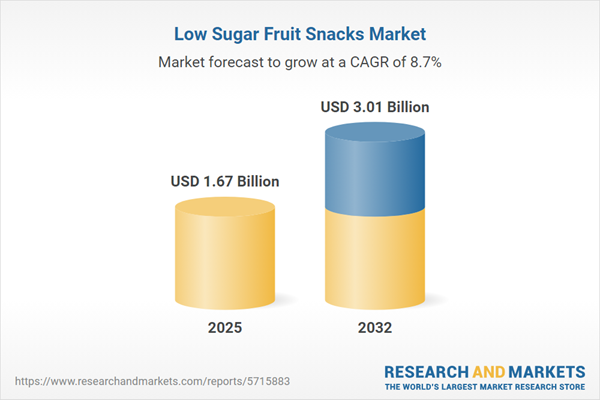Speak directly to the analyst to clarify any post sales queries you may have.
The low sugar fruit snacks market is evolving rapidly as senior executives face shifting consumer health demands, new regulatory requirements, and advances in supply chain technology. Staying informed with actionable insights empowers effective leadership and prepares organizations for both challenges and opportunities in this dynamic sector.
Market Snapshot: Low Sugar Fruit Snacks Market Outlook
The low sugar fruit snacks market is advancing at a pace exceeding much of the broader food and beverage industry. Ongoing consumer interest in health is accelerating demand in both established and emerging economies. Ingredient transparency has become a significant point of competition, while regulatory updates across major geographies are prompting organizations to revamp their approaches to both market entry and risk management. These pressures are driving companies to adapt logistics and shore up supply chains to serve regional demands more flexibly. At the same time, a renewed emphasis on digital channel strategies and agile brand positioning is enabling players to navigate heightened complexities. Leaders across manufacturing and marketing are now balancing compliance obligations with innovation to plot a course for viable, sustainable growth.
Scope & Segmentation of the Low Sugar Fruit Snacks Market
This report offers senior decision-makers a comprehensive breakdown of essential market drivers, key segments, and strategic imperatives shaping the future of low sugar fruit snacks:
- Product Types: Fruit bars target buyers with high nutrition and performance expectations; fruit rolls appeal to those with traditional snack preferences; gummy snacks support alternative nutritional needs; real fruit chews satisfy clean label and ingredient-conscious consumers.
- Pack Sizes: Family-size packs help address group consumption patterns, while single-serve packs are tailored for on-the-go convenience and individual use.
- Distribution Channels: Hypermarkets and supermarkets strengthen consumer interaction through in-store experiences; online retail channels extend digital presence and broaden distribution scalability.
- Regional Markets: The Americas, Europe, Middle East and Africa, and Asia-Pacific regions each reveal unique consumer patterns and regulatory demands, requiring market-specific logistics and marketing adaptation.
- Countries Profiled: The United States, Canada, Brazil, United Kingdom, Germany, China, India, and Australia highlight a diverse spectrum of regulatory environments and consumer behaviors that influence market entry and operational models.
- Leading Companies: Market leaders such as Better Juice, Ltd., Calbee, Inc., CeCe J’s Snacks, Ferrero Group, General Mills, Inc., PepsiCo, Inc., and Sunkist Growers, Inc. are recognized for their focus on innovation and exemplary supply chain management.
- Packaging Formats: Resealable, recyclable, and single-use packaging shapes both consumer purchasing habits and retailer strategies, reflecting evolving sustainability commitments industry-wide.
- Technology and Regulatory Adaptation: Advancements like plant-based sweeteners, automated supply chain systems, and sophisticated compliance processes keep pace with health-driven regulatory changes.
Key Takeaways for Senior Decision-Makers
- Innovative use of plant-based sweeteners and wider fruit sourcing positions companies to be responsive to changes in dietary trends and health motivations among global consumers.
- Investing in digital labeling solutions, such as QR codes, provides instant ingredient transparency and deepens consumer engagement across sales channels.
- Focusing on recyclable and flexible packaging options aligns sustainability commitments with retail performance improvement in both in-store and digital environments.
- Broadening product offerings and adjusting branding for emerging segments—traditional, performance-centric, and clean-label—helps organizations remain relevant and competitive.
- Offering various pack sizes across in-person and digital platforms accommodates changing consumption patterns and improves supply chain responsiveness.
- Adapting flavors and packaging design to regional preferences fosters deeper local market connections and strengthens brand resilience in a diverse marketplace.
Tariff Impact: Navigating 2025 U.S. Trade Adjustments
With new U.S. tariff changes anticipated to affect ingredient and packaging costs in the low sugar fruit snacks space, executives should prepare by reviewing procurement agreements, diversifying local supplier networks, and optimizing logistics. These measures will help ensure smooth distribution across all channels and limit disruption from cost increases.
Methodology & Data Sources
This report employs a rigorous approach, incorporating secondary research, executive interviews, consumer surveys, and end-to-end supply chain analyses. All findings have been validated by domain experts to support confident and data-driven decision-making among leaders managing the low sugar fruit snacks market.
Why This Report Matters
- Enables leadership to prioritize product and packaging innovation while promoting adaptability and long-term market strength.
- Delivers actionable insights for monitoring regulatory changes and channel shifts, supporting agile responses to evolving industry conditions.
- Advises on technological and regional priorities, ensuring that companies can capture emerging growth channels and build a robust competitive stance.
Conclusion
Success in the low sugar fruit snacks market depends on flexible strategies, relentless innovation, and a steadfast focus on compliance and sustainability. Staying aligned with global shifts will underpin stable, long-term organizational growth.
Additional Product Information:
- Purchase of this report includes 1 year online access with quarterly updates.
- This report can be updated on request. Please contact our Customer Experience team using the Ask a Question widget on our website.
Table of Contents
3. Executive Summary
4. Market Overview
7. Cumulative Impact of Artificial Intelligence 2025
Companies Mentioned
The companies profiled in this Low Sugar Fruit Snacks market report include:- Better Juice, Ltd.
- Calbee, Inc.
- CeCe J's Snacks
- Crispy Green Inc
- Ferrero Group
- General Mills, Inc.
- Mott's LLP
- PepsiCo, Inc.
- PIM Brands, Inc.
- Sunkist Growers, Inc.
Table Information
| Report Attribute | Details |
|---|---|
| No. of Pages | 188 |
| Published | November 2025 |
| Forecast Period | 2025 - 2032 |
| Estimated Market Value ( USD | $ 1.67 Billion |
| Forecasted Market Value ( USD | $ 3.01 Billion |
| Compound Annual Growth Rate | 8.6% |
| Regions Covered | Global |
| No. of Companies Mentioned | 11 |









